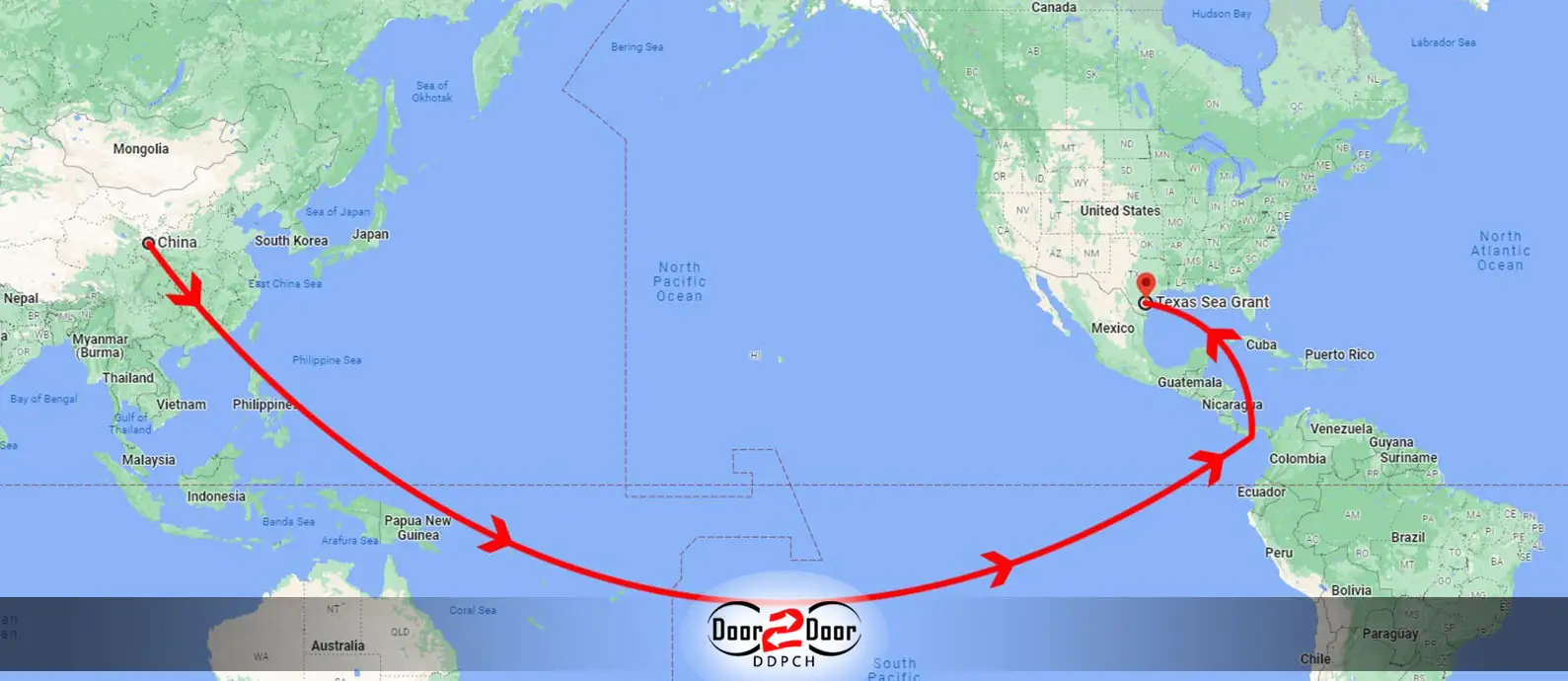Navigating International Shipping from China to Texas
At DDPCH Shipping Company, we have specialized in two key transportation services that have become essential in facilitating international shipping from China to Texas: air cargo and sea cargo. These two offerings enable us to provide comprehensive and tailored solutions for businesses seeking efficient and reliable shipping services.
Air Cargo
Our air cargo services are designed for those seeking fast and time-critical shipping from China to Texas. With a network that spans major airports in both regions, DDPCH ensures a streamlined process that prioritizes speed without sacrificing safety or reliability. Whether it’s high-value goods, perishable items, or urgent shipments, our air cargo solutions provide the efficiency you need. Real-time tracking and dedicated customer support ensure that our clients are always informed about their shipment’s status, providing peace of mind.
Sea Cargo
For businesses looking for an economical and environmentally friendly shipping option, our sea cargo services offer the perfect solution. DDPCH has established relationships with major shipping lines, providing access to a wide range of vessels and flexible scheduling. Our sea cargo services cater to both Full Container Load (FCL) and Less than Container Load (LCL) shipments, allowing for customization according to your specific needs and budget. We manage all aspects of the journey, including customs clearance, port handling, and warehousing, to ensure a seamless experience from origin to destination.
Both our air and sea cargo services include comprehensive cargo tracking and compliance with international shipping regulations. This commitment to transparency and adherence to global standards underscores our dedication to quality service.
At DDPCH, we understand that each client has unique shipping requirements. Whether you prioritize speed with our air cargo service or value efficiency with our sea cargo options, our team of experts is here to assist you every step of the way. With an unwavering commitment to excellence, we are poised to facilitate the ever-growing trade connection between China and Texas.
Trust in DDPCH for both your air and sea cargo needs, and let us provide the tailored shipping solutions that ensure success for your business.
Analyzing Air Cargo Costs : shipping from China to Texas
At DDPCH Shipping Company, we are committed to offering transparent and competitive air cargo services from China to Texas. When engaging in international shipping, understanding the cost structure is paramount for businesses to plan effectively. Here, we’ll break down the major components that determine air cargo costs between these two regions.
Freight Rates: This is the fundamental cost based on the weight and volume of the shipment. Air carriers often have different pricing structures, and our partnerships with various airlines enable us to offer competitive rates.
Fuel Surcharge: Fluctuating fuel prices can significantly impact shipping costs. We monitor these changes closely to provide our clients with the most accurate and up-to-date pricing.
Customs Clearance and Duties: Compliance with both Chinese and U.S. customs regulations is essential. Our expert team ensures that all the necessary documents are prepared accurately to avoid delays and additional costs.
Security and Handling Fees: Implementing stringent security measures and proper handling is vital to ensuring the safe transit of goods. These fees cover inspections and handling at both the origin and destination airports.
Insurance: Depending on the value and nature of the goods, insurance can be a critical component of shipping costs. We provide various insurance options to suit different needs and budgets.
Additional Services: Services like warehousing, special packaging, or expedited delivery will influence the total shipping cost. At DDPCH, we offer these as customizable options, allowing our clients to choose according to their specific requirements.
Seasonal Fluctuations: Demand and capacity constraints during peak seasons can influence air cargo rates. We advise our clients to plan ahead and work closely with our team to secure the best rates.
Route and Distance: The choice of direct or connecting flights and the overall distance will affect the cost. Our network allows for flexibility in routing, ensuring efficiency and cost-effectiveness.
Here’s a table that provides an example of air cargo cost estimation from Shanghai, China to Houston, Texas for a standard shipment:
Please note that these costs are indicative and can vary based on various factors. We encourage businesses to contact our DDPCH team for a detailed and personalized quote tailored to their specific shipping needs.
At DDPCH Shipping Company, we strive to provide a comprehensive understanding of the costs involved, ensuring that our clients can make informed decisions for their air cargo shipping from China to Texas.
Estimating Air Cargo Arrival : China to Texas Route
At DDPCH Shipping Company, we understand the importance of accurate arrival time estimates for air cargo shipping between China and Texas. This critical information helps businesses to plan, reducing uncertainty and enhancing efficiency. Here are some key factors that contribute to arrival time estimates and examples of various routes:
Flight Options: Direct flights offer the fastest transit times, while connecting flights may involve layovers that increase the duration.
Customs and Security Procedures: Compliance with customs regulations in both China and the United States can affect arrival time. At DDPCH, we manage this process meticulously to prevent unnecessary delays.
Airport Capabilities: Major international airports can handle cargo more quickly due to better infrastructure and more frequent flights. Smaller airports may require additional time for handling.
Weather and Seasonal Factors: Weather conditions and peak shipping seasons can cause delays in flight schedules.
Cargo Type and Special Handling Requirements: The nature of the goods and any special handling or inspection requirements may also influence arrival time.
Real-Time Monitoring and Coordination: We at DDPCH continuously monitor and coordinate with all parties involved to ensure smooth transitions between different stages of shipping, from takeoff to landing and beyond.
Local Transportation and Distribution: Once the cargo arrives in Texas, local ground transportation and distribution must be factored into the total delivery time.
Here is a table that provides real examples of different routes for air cargo arrival from China to Texas, including estimated transit times:
It’s essential to note that these are estimated times, and actual transit can vary based on the aforementioned factors. Moreover, the connecting routes may stop at different hub airports, affecting the total transit time.
DDPCH Shipping Company prioritizes keeping our clients informed about their shipment’s status. Our advanced tracking systems and dedicated customer service ensure businesses always have up-to-date information on their cargo’s journey from China to Texas.
Air cargo Routes : Departures from China , Arrivals in Texas
The international air cargo landscape is expansive, and the routes from China to Texas are no exception. Here are details about five distinct routes, each originating from a different city in China and arriving in Texas:
Shanghai Pudong (PVG) to Dallas/Fort Worth (DFW): This direct route is one of the most popular, connecting two major global hubs. With numerous flights weekly, the Shanghai to Dallas/Fort Worth route provides flexibility and speed. Shanghai, being China’s financial and commercial center, has a strong demand for various goods, making this route vital for international trade.
Beijing Capital (PEK) to Houston (IAH): The Beijing to Houston route often involves connecting flights, possibly through Chicago O’Hare (ORD) or Los Angeles (LAX). Beijing, as the political capital of China, has substantial international cargo traffic. Houston, known for its energy and medical sectors, receives a variety of specialized goods from Beijing.
Guangzhou (CAN) to Austin (AUS): This route might include a connection through a major hub like San Francisco (SFO). Guangzhou is a significant manufacturing and export center, making this route crucial for electronics, textiles, and other industrial goods. Austin’s growing tech industry benefits from this connection.
Shenzhen (SZX) to San Antonio (SAT): Shenzhen is renowned for its tech industry, and the route to San Antonio often supports the transportation of electronic components. This route may include direct flights or connections through major airports, offering diverse options to suit different needs.
Chengdu (CTU) to Dallas/Fort Worth (DFW): Chengdu, known for its automotive and aerospace industries, maintains a strategic connection to Dallas/Fort Worth. The route may offer both direct and connecting options, possibly through Shanghai or another major hub.
These routes symbolize the robust and complex nature of international air cargo shipping. Each reflects the unique economic, industrial, and logistical characteristics of the cities they connect. At DDPCH Shipping Company, we specialize in navigating these routes, ensuring smooth, efficient, and timely delivery. Our expert knowledge of these and other routes shipping from China to Texas equips us to tailor our services to the specific needs and goals of each client.
Understanding the various air cargo routes from China to Texas is key to optimizing shipping strategy. Whether direct or connecting, each route offers distinct opportunities and challenges that can impact cost, time, and reliability. Leveraging this knowledge effectively can create significant advantages in today’s competitive global marketplace.
Delving into Sea Cargo Cost: shipping from China to Texas
The complexity of estimating sea cargo costs between China and Texas requires consideration of several different aspects. Here is a detailed breakdown of the factors influencing the costs:
Port Fees:
- Origin and Destination Ports: The specific ports of origin and destination can greatly influence costs. Major ports might have higher handling fees, while smaller ones might involve additional logistics costs.
- Port Charges: These include fees for loading, unloading, and other services at the port. They can vary depending on the port’s facilities and the nature of the goods.
Shipping Container Costs:
- Container Type and Size: The choice of container (e.g., 20-foot, 40-foot, refrigerated) affects the price.
- Container Availability: In some cases, container shortages might increase the cost.
Freight Rates:
- Shipping Line Selection: Different shipping lines offer different rates, which can vary based on their reputation, reliability, and services.
- Seasonal Fluctuations: Demand during peak shipping seasons can lead to increased rates.
Customs and Regulations:
- Customs Duties and Taxes: Customs charges depend on the nature and value of the goods, and compliance with regulations.
- Documentation Costs: Proper documentation is vital, and errors can lead to delays and additional costs.
Insurance and Risk Management:
- Insurance Premiums: The type and value of goods, along with the chosen level of coverage, determine the insurance costs.
- Potential Risks and Liabilities: Special handling or hazardous materials might entail additional costs.
Logistical Factors:
- Transshipment: If the cargo needs to be transferred between different vessels, it can add to the costs.
- Inland Transportation: Costs related to transporting the goods from the origin to the port, and from the port of arrival to the final destination, should be considered.
Economic Factors:
- Currency Exchange Rates: Fluctuations in exchange rates between the currencies involved can impact the total cost.
- Market Conditions: Supply and demand dynamics in both China and Texas might influence pricing.
The process of estimating sea cargo costs from China to Texas is a complex task that requires careful consideration of these and other factors. Working with an experienced shipping partner like DDPCH Shipping Company ensures that all these aspects are handled efficiently. Our team of experts closely monitors all the variables and leverages our extensive network to offer competitive rates.
In conclusion, understanding the various aspects of sea cargo costs helps businesses in making informed decisions. Whether it’s selecting the right container or navigating the complexities of customs and regulations, each element plays a crucial role in defining the final cost.

Comparing Rates : China to Texas Container Shipments
Shipping containers from China to Texas represents a significant component of international trade and logistics. Rates for container shipments can vary extensively based on several interconnected factors, each contributing to the overall cost and logistics planning:
Container Size and Type: The container’s size and type are crucial in determining the shipping rate. Different sizes and specialized containers such as refrigerated units cater to various cargo needs and have distinct costs.
Type of Goods: Different goods have different shipping requirements and regulations, which affect the costs. Fragile, hazardous, or temperature-sensitive items may require specialized handling.
Shipping Lines and Routes: Rates can differ significantly between different shipping lines and routes. Factors like reliability, transit time, and additional services can impact the overall cost.
Seasonal and Market Fluctuations: Seasons influence demand, and during peak times, the rates can be higher. Market conditions, including fuel prices and currency exchange rates, also play a role.
Port Charges and Additional Fees: Charges at the ports of departure and arrival, customs duties, and additional services like door-to-door delivery can contribute to the overall cost.
Contractual Agreements: Longer-term agreements might offer better rates than one-time spot bookings.
At DDPCH Shipping Company, we facilitate comprehensive rate comparisons, tailored to our client’s unique shipping needs. Our expertise covers everything from selecting the right container size and type to navigating market dynamics, ensuring a cost-effective and smooth shipping experience.
Comparing rates for China to Texas container shipments is a multifaceted process. By understanding and leveraging these factors, businesses can make informed decisions that align with their logistical requirements and budget considerations.
Please note that these costs are indicative and may fluctuate based on the aforementioned factors. The type of goods listed represents common examples and is not exhaustive. For precise quotations and expert guidance on shipping different types of goods, consulting with a professional like DDPCH Shipping Company is recommended.
I hope this detailed analysis and table meet your needs. If there are any further adjustments or inquiries, please let me know!
Mapping the Sea : Shipping from China to Texas route
The China to Texas shipping route is one of the most vital in international trade, connecting two significant markets. The journey involves navigating a complex network of seas, oceans, straits, and channels. Here’s an overview of the primary considerations and potential paths:
- Major Ports in China: Key departure ports such as Shanghai, Shenzhen, Hong Kong, Qingdao, and Guangzhou serve as primary gateways for goods leaving China.
- Trans-Pacific Crossing: This is the primary oceanic leg of the journey, crossing the Pacific Ocean. It is the longest and most critical part of the shipping route.
- Panama Canal Option: Many shipments pass through the Panama Canal, a crucial shortcut that connects the Pacific and Atlantic Oceans. It saves time but involves additional fees and may have size restrictions for vessels.
- Alternative Routes via Suez Canal: Some shipping lines may choose to sail around Africa via the Suez Canal, although this is typically a longer route.
- US Gulf Ports: Texas hosts major ports like Houston, Galveston, and Corpus Christi, which are well-connected to global shipping networks.
- Seasonal and Weather Considerations: Typhoons, hurricanes, and other weather patterns can influence the choice of route, potentially leading to delays or detours.
- Regulatory Compliance: Different routes might require compliance with various international regulations and treaties, affecting the choice of path and overall costs.
- Type of Goods: The nature of the cargo, including size, weight, and special requirements, can determine the selection of the shipping route.
Best Route for Sea Shipping from China to Texas
For general cargo and most containerized goods, the optimal route would typically involve departing from a major Chinese port like Shanghai, crossing the Pacific Ocean, and passing through the Panama Canal before arriving at a Texan port like Houston. This route offers a balance of speed and cost-effectiveness.
For oversized or specialized cargo that may not be suitable for the Panama Canal, alternative routes might be chosen, considering factors like vessel size, cargo specifications, and delivery timelines.
At DDPCH Shipping Company, we leverage our expertise and technology to analyze these variables and select the best shipping routes for our clients. Our comprehensive understanding of the different paths, combined with real-time monitoring and adaptability, ensures that we offer the most efficient and cost-effective sea shipping solutions from China to Texas.

Explore the sea route from China to Texas, crossing the Pacific Ocean & Panama Canal.
Deciding Factors : Air vs Sea Freight for China to Texas
The choice between air and sea freight for shipping goods from China to Texas is influenced by several factors. Here’s an in-depth analysis of these deciding factors, along with a comparison of the advantages and disadvantages of both shipping modes:
Speed:
- Air Freight: It’s significantly faster, often taking only a few days.
- Sea Freight: Takes longer, usually several weeks.
- Decision Factor: If speed is crucial, air freight is the better option.
Cost:
- Air Freight: Generally more expensive due to faster delivery and higher fuel costs.
- Sea Freight: More economical, especially for bulk shipments.
- Decision Factor: If budget is a primary concern, sea freight might be preferred.
Volume and Weight:
- Air Freight: Limited capacity and weight restrictions.
- Sea Freight: Ideal for large, heavy, and bulky shipments.
- Decision Factor: For significant volumes, sea freight is usually more practical.
Environmental Impact:
- Air Freight: Higher carbon emissions.
- Sea Freight: Typically considered more environmentally friendly.
- Decision Factor: If sustainability is a priority, sea freight may be the better option.
Reliability:
- Air Freight: Generally more reliable with fixed schedules.
- Sea Freight: Can be subject to delays due to weather, port congestion, etc.
- Decision Factor: For time-sensitive shipments, air freight might be more suitable.
Nature of Goods:
- Air Freight: Ideal for perishables, high-value, or urgent items.
- Sea Freight: Suitable for bulky, heavy, or hazardous materials.
- Decision Factor: The type of goods being shipped will greatly influence the choice.
Regulatory Compliance:
- Air Freight: May require more stringent security checks.
- Sea Freight: Complex customs and port regulations.
- Decision Factor: Compliance requirements might affect the choice between air and sea.
The complex nature of ocean freight duration requires a comprehensive understanding of various influencing factors. By being mindful of these, businesses can plan effectively and make informed decisions that align with their shipping needs and timelines. Feel free to contact us if you need further assistance or specific information regarding your shipping requirements.
Top 5 Shipping Routes from China to Texas
Shipping from China to Texas involves several major routes, each with its unique characteristics and advantages. The decision on which route to take depends on various factors such as time, cost, type of goods, and more. Here’s an examination of the top 5 shipping routes from China to Texas, providing real examples.
1. Standard Route via the Panama Canal:
- Example: Shanghai to Houston
- Description: This popular route traverses the Pacific Ocean, entering the Panama Canal, and finally arriving at the Texan ports. It offers a relatively fast and cost-effective option for various types of cargo.
- Transit Time: Approximately 22-28 business days
2. Pacific Route via the West Coast of the U.S.:
- Example: Shenzhen to Galveston, via Los Angeles
- Description: This route enters the U.S. through West Coast ports like Los Angeles and then continues by land or coastal shipping to Texas. It can be advantageous for specific logistical needs.
- Transit Time: Around 25-30 business days
3. Route via Suez Canal and the Atlantic Ocean:
- Example: Guangzhou to Corpus Christi, via Suez Canal
- Description: Although unconventional for shipping to Texas, this route could be used depending on the cargo’s nature or strategic alignment with other shipping needs, passing through the Indian Ocean and the Suez Canal.
- Transit Time: Approximately 30-35 business days
4. Alternative Pacific Route via Mexico:
- Example: Qingdao to Houston, via Manzanillo, Mexico
- Description: This route involves transshipment through Mexican ports like Manzanillo and then forwarding to Texas. It might be selected based on cargo requirements or shipping line preferences.
- Transit Time: Around 24-29 business days
5. Trans-Pacific Route with Caribbean Transshipment:
- Example: Hong Kong to Dallas, via Kingston, Jamaica
- Description: This unique route includes transshipment through Caribbean ports like Kingston, providing flexibility and possibly aligning with specific shipping strategies or cargo consolidation.
- Transit Time: Approximately 23-28 business days
These top 5 shipping routes from China to Texas offer various options for shippers to align with their specific needs, budgets, and timelines. At DDPCH, we understand the nuances of each route and work with our clients to select the best option for their particular situation. Real-life considerations, such as the nature of goods, weather patterns, and geopolitical factors, play a crucial role in making an informed choice.

Supplier-to-Texas Freight : Can It Be Done?
The global supply chain network has become increasingly interconnected, with Texas playing a vital role as a destination for various products. A significant portion of these imports comes from China, a manufacturing powerhouse. In this scenario, the direct supplier-to-Texas freight model becomes intriguing for many businesses.
Example : Texas-Based Electronics Retailer
Imagine a Texas-based electronics retailer aiming to source high-quality headphones from China. Here’s how the process unfolds:
- Supplier Search: The retailer attends an electronics trade show in Shenzhen, China, where they discover a reputable headphone manufacturer. A business relationship is established, and a deal is negotiated.
- Production and Quality Control: The Chinese supplier manufactures the headphones and conducts quality control checks as per the retailer’s specifications.
- Shipping Arrangements: The retailer coordinates with DDPCH for the shipping logistics. The headphones are loaded into containers and transported from Shenzhen to the Port of Houston, Texas.
- Customs and Regulations Compliance: DDPCH ensures that all customs documentation is in order, and all relevant U.S. regulations are followed for a smooth importing process.
- Final Delivery in Texas: The goods are transported from Houston to the retailer’s distribution center in Dallas. The entire process is monitored closely to ensure timely and safe delivery.
Supplier-to-Texas freight is not only feasible but also a strategic decision that can lead to cost savings, efficiency, and direct control over the supply chain. Finding the right supplier in China requires a combination of research, networking, and collaboration with platforms or agents that specialize in connecting businesses with manufacturers.
The example of the Texas-based electronics retailer demonstrates that, with the right planning, collaboration with a reliable shipping partner like DDPCH, and adherence to relevant regulations, direct shipping from a Chinese supplier to Texas becomes an attainable and advantageous business strategy.
Step-by-Step: Shipping Guide from China to Texas
Shipping from China to Texas is a multifaceted process that involves several crucial steps. Whether you choose air freight or sea freight, understanding the journey from the manufacturer to the destination is vital. Here’s a step-by-step guide to both methods, followed by a comparison.
Air Freight Steps
a. Identifying Suitable Route and Carrier: The first step is to find the right route and airline that meets the requirements, considering factors like time sensitivity, budget, and regulations.
b. Booking Cargo Space: Once the carrier is selected, booking space in advance is essential to ensure availability.
c. Preparing Documentation: This includes the airway bill, packing list, commercial invoice, and any required export licenses.
d. Packaging and Labeling: Proper packing and labeling must comply with international air transportation regulations.
e. Customs Clearance in China: All the documentation is presented to Chinese Customs, and the necessary duties and taxes are paid.
f. Transportation to Airport: The goods are transported to the airport for loading onto the plane.
g. Flight to Texas: The cargo is flown to the selected airport in Texas, such as Dallas/Fort Worth International Airport.
h. Customs Clearance in Texas: The U.S. Customs reviews the documentation, and the goods are cleared for entry.
i. Final Delivery: The shipment is picked up from the airport and transported to its final destination in Texas.
Sea Freight Steps
a. Identifying Suitable Route and Carrier: Finding the right shipping line and route, often via the Pacific Ocean and Panama Canal.
b. Booking Container Space: The appropriate container size and space on the vessel are booked.
c. Preparing Documentation: Similar to air freight, including the Bill of Lading.
d. Packaging and Labeling: This follows international maritime shipping standards.
e. Customs Clearance in China: Necessary customs paperwork is filed, and fees are paid.
f. Transportation to Port: Goods are transported to a Chinese seaport, such as Shanghai.
g. Sea Voyage to Texas: The shipment embarks on the journey to a Texas port like the Port of Houston.
h. Customs Clearance in Texas: Same as air freight but may include additional inspections.
i. Final Delivery: The goods are transported to their final Texas destination.
While the fundamental steps for both methods are similar, the main differences lie in:
- Time: Air freight is faster, often taking a few days, while sea freight may take weeks.
- Cost: Air freight is generally more expensive due to the speed, whereas sea freight offers cost-effective solutions for bulk shipping.
- Environmental Regulations: Compliance with different sets of international regulations for air and sea freight.
- Capacity and Weight Considerations: Air freight has stricter limitations on weight and volume compared to sea freight.
The step-by-step process of shipping from China to Texas, whether by air or sea, involves careful planning, adherence to regulations, and coordination with reliable logistics partners. Understanding the differences between the two methods allows businesses to make informed decisions that align with their budget, timeline, and shipment requirements.
Final Thoughts: China to Texas Freight Possibilities
The expansive trade corridor connecting China and Texas represents a vital and vibrant part of the global supply chain. Both air and sea freight options provide versatile solutions to businesses looking to move goods between these two major economic regions. At DDPCH shipping company, we understand that each method of shipping offers unique advantages, and we’re dedicated to helping our clients navigate these options. Through the implementation of cutting-edge technology, we provide real-time tracking and automation of various shipping processes. This enables more informed decisions and better coordination, enhancing overall efficiency and customer satisfaction.
China to Texas freight possibilities are vast and varied, and selecting the right mode of transport is critical to success. At DDPCH, we pride ourselves on our ability to tailor solutions, ensuring compliance, leveraging technology, and acting responsibly in our approach to shipping. We’re not just a shipping company; we’re a partner committed to making the global marketplace more accessible and efficient. Whether it’s air or sea freight, we stand ready to support your business, connecting China and Texas with seamless and strategic shipping solutions.
Conclusion
Navigating the complex waters of international shipping, especially between major trade hubs like China and Texas, requires comprehensive understanding, meticulous planning, and an adept logistics partner. This guide has provided a deep dive into the various aspects of shipping, touching upon the intricacies of both air and sea freight.
From the outset, it’s evident that both air and sea freight have their distinct advantages. While air freight stands out for its speed, making it suitable for time-sensitive shipments, sea freight is more cost-effective, especially for bulk shipments. Choosing between the two requires a thorough assessment of your business’s specific needs – from budget constraints to delivery timelines.
DDPCH, as highlighted throughout the guide, emerges as a partner that businesses can trust. With their emphasis on tailored solutions, real-time tracking via technological advancements, and commitment to sustainability and regulatory compliance, they are positioned to simplify the complexities of international shipping.
Explore our extensive shipping guides tailored for major urban centers including Los Angeles, Florida , Chicago, Seattle, Virginia and New York.
The main steps for air freight shipping from China to Texas include identifying a suitable route and carrier, booking cargo space, preparing necessary documentation, ensuring appropriate packaging and labeling, clearing customs in both China and Texas, transporting goods to and from the airport, and ensuring the final delivery within Texas.
While both methods involve selecting carriers, booking space, preparing documents, and clearing customs, there are nuances. Air freight is generally faster, taking only a few days, while sea freight may take weeks. Additionally, sea freight allows for bulk shipments, making it cost-effective for large quantities, whereas air freight often has stricter weight and volume limitations.
Direct supplier-to-Texas shipments require careful planning, adherence to regulations, and coordination with a reliable logistics partner. Challenges can include finding the right supplier, managing production quality, navigating international customs, and ensuring timely delivery.
Sea freight is generally more cost-effective for bulk shipments due to its ability to handle larger capacities. While air freight offers speed, sea freight provides economic advantages, especially for businesses shipping large quantities of goods.
Finding suppliers can be accomplished through trade shows and expos, online B2B marketplaces like Alibaba, hiring sourcing agents with local expertise, or collaborating with industry associations and chambers of commerce in China. Due diligence in research and vetting is essential for selecting a trustworthy supplier.
DDPCH offers tailored shipping solutions based on individual business needs, provides expertise in navigating complex international shipping regulations, leverages technology for efficient real-time tracking, prioritizes environmental considerations, and aims to foster long-term partnerships with clients by understanding and catering to their unique requirements.
DDPCH has extensive knowledge of both Chinese and U.S. customs procedures and manages all necessary paperwork, licenses, and compliance requirements. Their dedication to transparency and strict adherence to regulations ensures a seamless shipping experience for their clients.
A Texas-based retailer sourcing headphones from a Chinese manufacturer exemplifies supplier-to-Texas shipping. This process includes supplier search, production, quality control, shipping arrangements, customs compliance, and final delivery, all coordinated with DDPCH’s support
The top shipping routes include both air and sea connections from major Chinese cities like Shanghai, Shenzhen, Beijing, Guangzhou, and Hong Kong to Texas ports and airports like the Port of Houston or Dallas/Fort Worth International Airport. Routes may vary based on factors such as cost, time, and specific shipping needs.
Sea cargo typically travels via the Pacific Ocean, often passing through the Panama Canal, before reaching a major Texan port such as the Port of Houston.
Absolutely! DDPCH employs cutting-edge technology to automate various shipping processes, including offering real-time tracking capabilities. This feature allows clients to make informed decisions and ensures better coordination throughout the shipping journey.






